by Paige Casteel
Have you noticed your Newf is crazy about water or toys? Are you working towards your Water Rescue Dog title and want to instill a love of jumping from the boat? Maybe you’ve heard about one of the fastest growing dog sports and wondered if your Newf might love dock diving? Whether you’re looking for a way to beat the heat, want to earn a new title or build good jump mechanics from the ground up, we’d encourage you to try dock diving.
Where to Start?
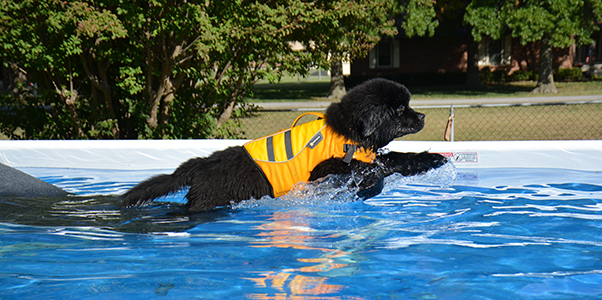 There are a few different organizations serving the dock diving community but among the most popular are North America Diving Dogs (NADD),Dock Dogs and Ultimate Air Dogs. Visit each of these organizations’ websites and you’ll see they hold events around the country and have affiliate facilities or clubs where you can get started learning the sport.
There are a few different organizations serving the dock diving community but among the most popular are North America Diving Dogs (NADD),Dock Dogs and Ultimate Air Dogs. Visit each of these organizations’ websites and you’ll see they hold events around the country and have affiliate facilities or clubs where you can get started learning the sport.
How does it work?
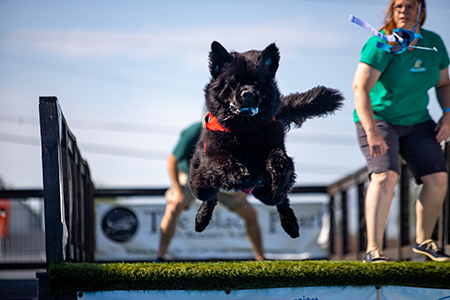 The dock can be indoors or outside, at a facility or mobile dock, using a pool or a natural body of water. You and your Newf will both be on the dock roughly 40 feet long and your dog will be leaving your side to jump into the water, retrieving a toy you’ve thrown, or a bumper located over the water or at the end of the pool, depending on the specific type of event.
The dock can be indoors or outside, at a facility or mobile dock, using a pool or a natural body of water. You and your Newf will both be on the dock roughly 40 feet long and your dog will be leaving your side to jump into the water, retrieving a toy you’ve thrown, or a bumper located over the water or at the end of the pool, depending on the specific type of event.
So what are the main types of events? What it’s called depends on the organization, but most fall into three categories:
• Big Air / Distance –The handler throws a toy from the dock and the dog jumps into the water with the goal being the farthest jump possible as measured from the end of the dock to where the dog enters the water.
• Extreme Vertical or Air Retrieve – A bumper is placed at a certain fixed height or distance from the dock and the dog will jump from the dock with the goal of retrieving the fixed bumper. You want to get the highest or farthest grab respectively.
• Speed Retrieve / Hydro Dash – A bumper is placed at the end opposite the pool from the dock and the dog jumps into the water, with a goal of retrieving the bumper and returning with it in the fastest time.
First Things First
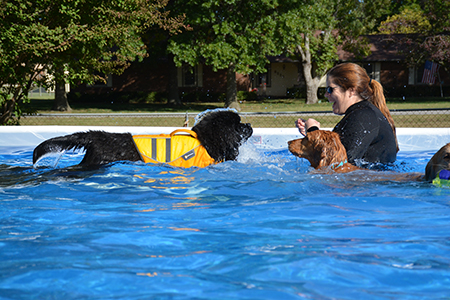 Your Newf will need to run, leap, swim, retrieve and exit via the ramp so talk to your vet and make sure your dog is in good health. If you’ve got a young dog, you’ll want to talk to your vet about jumping and consider delaying jumping from an elevated dock until they are older and growth plates have closed. Your dock diving Newfie is an athlete so don’t forget a good warm up and cool down. It’s always smart to keep a good conditioning routine and keep an eye out for change in behaviors while visiting your vet more often to ensure your Newf is in top shape.
Your Newf will need to run, leap, swim, retrieve and exit via the ramp so talk to your vet and make sure your dog is in good health. If you’ve got a young dog, you’ll want to talk to your vet about jumping and consider delaying jumping from an elevated dock until they are older and growth plates have closed. Your dock diving Newfie is an athlete so don’t forget a good warm up and cool down. It’s always smart to keep a good conditioning routine and keep an eye out for change in behaviors while visiting your vet more often to ensure your Newf is in top shape.
No matter your Newf’s age or type of event you attempt for the first time, you’ll want to make sure your dog can swim. As a matter of fact, dock diving facilities can be fantastic places to help your Newfie learn how to swim. If you can find an indoor facility in your area, you can work during the winter months which is great for keeping your dog in shape all-year long.
Getting your feet wet
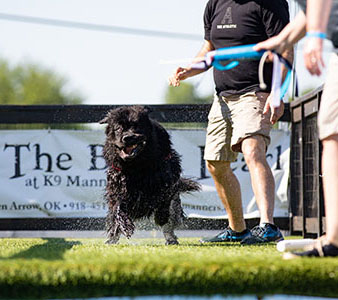 Just because you’re starting to dock dive doesn’t mean you’re going to start from the dock. The ramp will be where you spend your time building the foundation behavior of launching. This behavior comes in really handy in water rescue so take your time and make it fun. The best approach is to get into the water or have a helper in the water to encourage your Newf to leave for whatever they find most enticing--whether that’s a toy, a treat or a person will depend on what your Newf loves most.
Just because you’re starting to dock dive doesn’t mean you’re going to start from the dock. The ramp will be where you spend your time building the foundation behavior of launching. This behavior comes in really handy in water rescue so take your time and make it fun. The best approach is to get into the water or have a helper in the water to encourage your Newf to leave for whatever they find most enticing--whether that’s a toy, a treat or a person will depend on what your Newf loves most.
Start your Newf at the bottom of the ramp basically in the water and entice him to come to you (or a helper) a little farther out in the water. As the dog gets more comfortable you can progress up the ramp and eventually you will be throwing a toy into the water with them next to your side at the top of the ramp. They will be running down the ramp and launching out into the water after the toy.
If your Newf is hesitant, don’t panic. Some dogs have an aversion to pools and if you find that’s the case you might try a lake or pond instead. Or you may find inviting a confident dog friend to the party will encourage your Newf to take that first leap.
OK, but what about that dock?
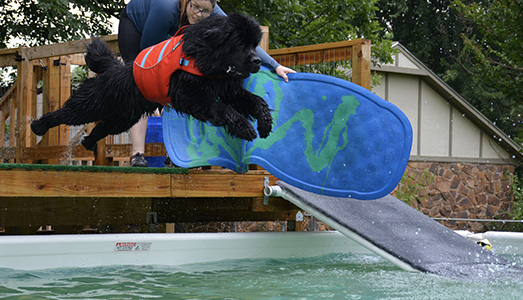 Continue throwing a toy from the top of the ramp and move up to the dock once a dog is old enough to do so safely, has demonstrated good swimming ability, understands how to exit the pool via the ramp, has mastered the footwork of launching and is totally confident in their jumping abilities.
Continue throwing a toy from the top of the ramp and move up to the dock once a dog is old enough to do so safely, has demonstrated good swimming ability, understands how to exit the pool via the ramp, has mastered the footwork of launching and is totally confident in their jumping abilities.
But take a few precautions. First, it’s smart to use a life jacket here, especially with a Newf. The jacket will allow you to keep the dog’s head above water and ensure they don’t hit the bottom of the relatively shallow 4’ deep pool. Second, think about using a visual barrier to block the dog’s view of the ramp if the dock doesn’t have one. Having done your job, your Newf loves the ramp and is used to being rewarded from jumping from it, so they might be inclined to jump to the ramp first before launching into the water. A visual barrier can encourage them to go out into the water instead of directly to their old friend.
Start your Newf about half the distance from the end of the dock to the edge and tease your dog with the toy as you did previously. Walk to the edge and make sure the toy is at dog’s eye level and encourage / cue the dog to run while throwing the toy out just barely in front of him. Watch with pride as your Newfie flies!
OK, I’ve got the basics, but how do we improve performance?
No matter what type of event you want to enter, building toy drive will serve you well and your Newf will perform best with a combination of speed and lift.
Speed
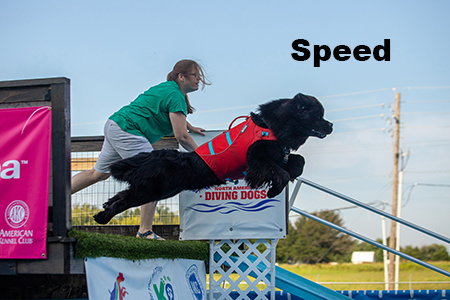 Figure out what toy makes your Newf crazy and only bring it out for dock diving. Tell him to wait, walk a few steps away and tease him with it. Tell him to get it, praising liberally and playing with him when he comes flying in for the toy. Once your dog is old enough to safely jump, hold the toy up a bit and play the same game, but let him grab the toy while jumping. Don’t overdo it as you want to protect your Newf’s health, but working toy drive on land can translate into great jumping ability on the dock. You want the dog driving down the dock as fast as possible and gunning for that toy.
Figure out what toy makes your Newf crazy and only bring it out for dock diving. Tell him to wait, walk a few steps away and tease him with it. Tell him to get it, praising liberally and playing with him when he comes flying in for the toy. Once your dog is old enough to safely jump, hold the toy up a bit and play the same game, but let him grab the toy while jumping. Don’t overdo it as you want to protect your Newf’s health, but working toy drive on land can translate into great jumping ability on the dock. You want the dog driving down the dock as fast as possible and gunning for that toy.
Lift
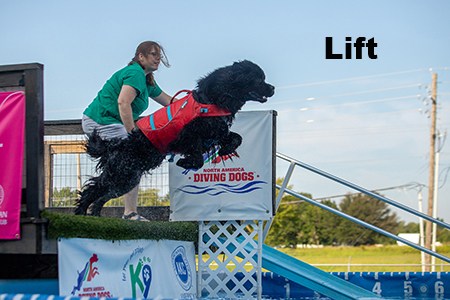 Even 130 pound dogs can get lift and lift has a LOT to do with toy drive and your throw. Many people make the mistake of thinking they need to throw the bumper as far as possible when what helps most is to perfect the timing and placement of your throw. Your throw is the contribution you bring to the team, so practice a lot! You want to keep the toy in your dog’s line of sight and throw up to encourage lift.
Even 130 pound dogs can get lift and lift has a LOT to do with toy drive and your throw. Many people make the mistake of thinking they need to throw the bumper as far as possible when what helps most is to perfect the timing and placement of your throw. Your throw is the contribution you bring to the team, so practice a lot! You want to keep the toy in your dog’s line of sight and throw up to encourage lift.
Troubleshooting
OK, so maybe you’ve practiced but your throw is still hideous. You might try the “place and send” method instead. Leave your dog and walk to the edge to throw the toy, returning to your dog and sending him to fetch the toy from the water instead. Some dogs do better with this method, so experiment and see what works best.
At some point you may discover your dog hesitating at the end of the dock. Putting on the brakes at the end will make for shorter distances so just start using less of the dock. If you’ve ruled out a physical issue, try If you were setting him up at the 30’ mark, try the 20’ mark insteadyour dog up for a shorter run. Once any issues have been worked out, you can begin moving the dog’s start position further back on the dock.
Your dock diving Newfie is an athlete and every athlete should have a good warm up and cool down. It’s always smart to keep a good conditioning routine and keep an eye out for change in behaviors while visiting your vet more often to ensure your Newf is in top shape.
We’re killing it, what’s next?
So you’re a rock star team and are ready to enter a trial or competition. With all organizations mentioned you can earn recognition, and with North America Diving Dogs you can even earn AKC-recognized titles. It’s a fun way to spend the day with your Newf around water and other water-loving dogs.
Successfully learning to fly can mean fun days at trials, new titles and confident jumping from a boat--such an important part of performing beautiful water rescue work. We hope to see you and your Newfs on the dock and flying off the boat next summer!
photo/video credits: Matt Casteel and Kara Hamilton